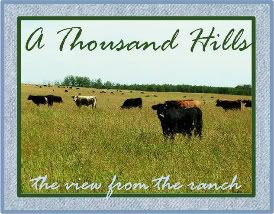 |
| The cows in North Quarantine. |
East Quarantine - cull and open cows - meaning those that have no baby in them.
South Quarantine - the bulls.
Meadow One - replacement heifers.
Feedlot Three - colts
Pen One - sick calves, which are doctored by the cowboys, as needed.
 |
| One of the mares. |
Every pen does not have to be fed every day, so it's somewhat of a memory juggling act. It only takes about 2.5 hours to feed the feedlot, even though it sound like a lot of animals to feed.
Sanchez does not have a hay buster. Instead, he has a knife, a very well used tool on the ranch. He can bring in only one bale at a time from the Bottom Stackyard. He has to get out of the tractor, cut the twine all the way down one side of the bale, pull off and wrap up the twine, and stuff it in his tractor. It's not good for the cows to eat twine. About the same as getting string in your salad. Not very tasty, I don't think.
After Sanchez is done feeding, he takes all the twines to the burn pit. He is always done before we get back to the yard.
After I'm done in NQ, I head to the shop. There, I burn all the twines off the "flails" of the bale buster with a bar iron. A bar iron is an electric bar, kind of like a straightened oven element.
After the twines are all removed from the flails, R takes the twines to the burn pit. I open the shop door, and when R returns, he backs his tractor unit in first. Sanchez's tractor is already in. Then I put my unit away. The hay buster unit is last into the shop, and first out in the morning. The hay buster is greased every day, and the tractor loaders, every Monday. Equipment breakdowns can be costly.
We are done by noon. Just in time for lunch!
In the winter, the main job is to feed, and once that's done, we're finished. Three thousand animals fed and happy. Sometimes, the "Roughrider Fan" (hay trucker) comes in with a load of bales (38 bales to a load) and "The Cowboy" will phone whoever's around to grab a tractor and unload the bales in the desired stackyard. Everyone carries a phone, as you never know where anyone is. That is how we communicate.
We also use hand signals a lot of the time when in the tractors. It's fast and easy.
Oh, and when I talk about the tractors we use, it's ALL John Deere!
GO GREEN!








